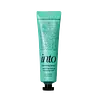What's inside
What's inside
 Key Ingredients
Key Ingredients

 Benefits
Benefits

 Concerns
Concerns

 Ingredients Side-by-side
Ingredients Side-by-side

Ethylhexyl Palmitate
EmollientOlea Europaea Fruit Oil
MaskingTrihydroxystearin
Skin ConditioningVitis Vinifera Seed Oil
EmollientPEG-20 Glyceryl Triisostearate
EmollientCetearyl Alcohol
EmollientOzokerite
Emulsion StabilisingGlyceryl Caprylate
EmollientTocopheryl Acetate
AntioxidantPyrus Communis Fruit Extract
Skin ConditioningRosa Damascena Flower Water
MaskingIris Florentina Root Extract
MaskingCucumis Melo Seed Extract
Skin ConditioningHedera Helix Leaf/Stem Extract
AntimicrobialMelia Azadirachta Leaf Extract
Skin ConditioningMelia Azadirachta Flower Extract
Skin ConditioningCoccinia Indica Fruit Extract
Skin ConditioningAmber Powder
Moringa Oleifera Seed Oil
EmollientCurcuma Longa Root Extract
MaskingOcimum Sanctum Leaf Extract
Skin ConditioningOrbignya Oleifera Seed Oil
EmollientCorallina Officinalis Extract
Skin ConditioningSclerocarya Birrea Seed Oil
HumectantHelianthus Annuus Seed Oil
EmollientCurcuma Longa Root Oil
PerfumingHippophae Rhamnoides Fruit Oil
Skin ProtectingTocopherol
AntioxidantEthylhexyl Palmitate, Olea Europaea Fruit Oil, Trihydroxystearin, Vitis Vinifera Seed Oil, PEG-20 Glyceryl Triisostearate, Cetearyl Alcohol, Ozokerite, Glyceryl Caprylate, Tocopheryl Acetate, Pyrus Communis Fruit Extract, Rosa Damascena Flower Water, Iris Florentina Root Extract, Cucumis Melo Seed Extract, Hedera Helix Leaf/Stem Extract, Melia Azadirachta Leaf Extract, Melia Azadirachta Flower Extract, Coccinia Indica Fruit Extract, Amber Powder, Moringa Oleifera Seed Oil, Curcuma Longa Root Extract, Ocimum Sanctum Leaf Extract, Orbignya Oleifera Seed Oil, Corallina Officinalis Extract, Sclerocarya Birrea Seed Oil, Helianthus Annuus Seed Oil, Curcuma Longa Root Oil, Hippophae Rhamnoides Fruit Oil, Tocopherol
Ethylhexyl Palmitate
EmollientHydrogenated Ethylhexyl Olivate
EmollientHydrogenated Olive Oil Unsaponifiables
EmollientPEG-20 Glyceryl Triisostearate
EmollientCyclopentasiloxane
EmollientWater
Skin ConditioningHydrogenated Microcrystalline Cera
Cera Microcristallina
Emulsion StabilisingGlyceryl Stearate
EmollientPEG-100 Stearate
Cetearyl Alcohol
EmollientLactic Acid
BufferingGlycolic Acid
BufferingVaccinium Myrtillus Fruit Extract
Skin ConditioningSaccharum Officinarum Extract
MoisturisingCitric Acid
BufferingCitrus Aurantium Dulcis Fruit Extract
MaskingCitrus Limon Fruit Extract
MaskingAcer Saccharum Extract
Skin ConditioningTartaric Acid
BufferingMalic Acid
BufferingGlyceryl Caprylate
EmollientGlyceryl Undecylenate
EmollientTocopherol
AntioxidantEthylhexyl Palmitate, Hydrogenated Ethylhexyl Olivate, Hydrogenated Olive Oil Unsaponifiables, PEG-20 Glyceryl Triisostearate, Cyclopentasiloxane, Water, Hydrogenated Microcrystalline Cera, Cera Microcristallina, Glyceryl Stearate, PEG-100 Stearate, Cetearyl Alcohol, Lactic Acid, Glycolic Acid, Vaccinium Myrtillus Fruit Extract, Saccharum Officinarum Extract, Citric Acid, Citrus Aurantium Dulcis Fruit Extract, Citrus Limon Fruit Extract, Acer Saccharum Extract, Tartaric Acid, Malic Acid, Glyceryl Caprylate, Glyceryl Undecylenate, Tocopherol
Alternatives
Ingredients Explained
These ingredients are found in both products.
Ingredients higher up in an ingredient list are typically present in a larger amount.
Cetearyl alcohol is a mixture of two fatty alcohols: cetyl alcohol and stearyl alcohol. It is mainly used as an emulsifier. Emulsifiers help prevent the separation of oils and products. Due to its composition, it can also be used to thicken a product or help create foam.
Cetearyl alcohol is an emollient. Emollients help soothe and hydrate the skin by trapping moisture.
Studies show Cetearyl alcohol is non-toxic and non-irritating. The FDA allows products labeled "alcohol-free" to have fatty alcohols.
This ingredient is usually derived from plant oils such as palm, vegetable, or coconut oils. There is debate on whether this ingredient will cause acne.
Due to the fatty acid base, this ingredient may not be Malassezia folliculitis safe.
Learn more about Cetearyl AlcoholEthylhexyl Palmitate, also known as octyl palmitate, is created from 2-ethylhexyl alcohol and palmitic acid. It is a fatty acid ester.
The fatty acid content of Ethylhexyl Palmitate makes it an emollient. Emollients help soften and hydrate your skin by trapping moisture within.
Ethylhexyl Palmitate is also used to help improve the texture of cosmetics. It helps other ingredient dissolve in products and help disperse ingredients more evenly.
You'll likely find this ingredient in sunscreen, as it is often used to mix UV-blocking ingredients such as avobenzone and ethylhexyl triazone.
It can also help stabilize the fragrances in a product as a fragrance fixative.
Ethylhexyl Palmitate can be used to substitute mineral oil.
Due to its high fatty acid content, it may not be fungal-acne safe.
Learn more about Ethylhexyl PalmitateGlyceryl Caprylate comes from glycerin and caprylic acid, a fatty acid from coconut. It has emollient and emulsifier properties.
As an emollient, it helps hydrate your skin. Emollients work by creating a barrier on your skin to trap moisture in, helping to keep your skin soft and smooth.
On the other hand, emulsifiers prevent ingredients (such as oil and water) from separating.
Learn more about Glyceryl CaprylatePeg-20 Glyceryl Triisostearate comes from Isostearic Acid and glycerin.
It is an emollient, emulsifier, and gentle cleanser. As an emollient, it helps trap moisture to keep skin soft and hydrated. Emulsifiers help prevent ingredients from separating.
This ingredient is common in oil-based products. This is because it helps oil-ingredients be easily washed away without leaving a residue.
Peg-20 Glyceryl Triisostearate may not be fungal-acne safe.
Learn more about PEG-20 Glyceryl TriisostearateTocopherol (also known as Vitamin E) is a common antioxidant used to help protect the skin from free-radicals and strengthen the skin barrier. It's also fat soluble - this means our skin is great at absorbing it.
Vitamin E also helps keep your natural skin lipids healthy. Your lipid skin barrier naturally consists of lipids, ceramides, and fatty acids. Vitamin E offers extra protection for your skin’s lipid barrier, keeping your skin healthy and nourished.
Another benefit is a bit of UV protection. Vitamin E helps reduce the damage caused by UVB rays. (It should not replace your sunscreen). Combining it with Vitamin C can decrease sunburned cells and hyperpigmentation after UV exposure.
You might have noticed Vitamin E + C often paired together. This is because it is great at stabilizing Vitamin C. Using the two together helps increase the effectiveness of both ingredients.
There are often claims that Vitamin E can reduce/prevent scarring, but these claims haven't been confirmed by scientific research.
Learn more about Tocopherol